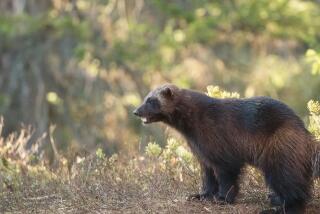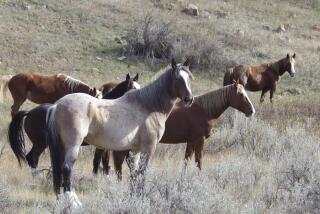How to Adopt a Wild Horse
- Share via
If you love mustangs, thank a little girl. Once the prey of ruthless trappers and “mustangers,” all wild horses and burros are now protected by the Wild Free-Roaming Horse and Burro Act of 1971. Congress passed the act after thousands of horse-loving grade-school girls across the country joined a campaign organized by Nevada resident Velma “Wild Horse Annie” Johnston to halt the capture and destruction of the animals. She organized schoolchildren to petition their representatives to stop the horses from being destroyed and sold as pet food. The act recognizes these animals as “living symbols of the historic and pioneer spirit of the West.”
Today, the Bureau of Land Management and the U.S. Forest Service protect and manage the herds, which roam throughout 200 identified wild horse territories in 10 Western states. According to the bureau, there are about 40,000 wild horses and 5,000 wild burros in America today.
For the record:
12:00 a.m. June 28, 2000 For the Record
Los Angeles Times Wednesday June 28, 2000 Home Edition Southern California Living Part E Page 3 View Desk 2 inches; 39 words Type of Material: Correction
Wild horses--Contact information for a group that tracks wild mustangs was left off a story in Tuesday’s Southern California Living. For more information, contact Rock Creek Pack Station through its Web site at https://www.rockcreekpackstation.com, or call (760) 935-4493.
Unlike the wild mustang herds outside Bishop, where mountain lions control and even threaten the horse population, most herds increase 15% to 20% each year, according to the land bureau. Herds that are too large threaten the environment by wiping out vegetation essential for other animals. The land bureau manages this increase through selective birth control and adoption programs.
Every year, private individuals adopt between 6,000 and 8,000 wild horses through the land bureau, according to Mindy Odom, who heads California’s wild horse adoption program in Bakersfield. Since 1973, the program has placed more than 148,000 wild horses and burros into private care.
Adoption fees are $125 per horse or more in case of an auction. The real costs--in feeding, housing, supplies, vet bills and training--come later.
Craig London, a Bishop-based veterinarian who has adopted a dozen or so wild horses, says to adopt them young. Horses much older than 2 don’t train well. Also, be ready for a long-term commitment. Horses shouldn’t be ridden regularly until they’re 5 or older.
And even with a young horse, there’s no guarantee. While some wild horses have gone on to be champions on racetracks and in rings, others never come around. If a horse doesn’t work out, the land bureau will take the horse back and try to find it another home. If no one adopts it by age 9, the horse gets turned loose onto a wild horse sanctuary, a protected and privately owned area. The horse won’t go back into the wild. Fortunately, most adoptions work out, Odom says. Fewer than 5% don’t.
Those who have mustangs like the fact that they never lose their attitude. As a group, they tend to be highly aware and a bit impatient. Odom, who has four adopted mustangs, believes they’re also more affectionate than domestic horses.
“I go out in my yard and all my mustangs whinny and run over; my domestic horse just stands there. The mustangs have figured out you’ll take care of them, and they don’t take it for granted.”
For more information about wild horse adoption, check the land bureau’s Web site at https://www.blm.gov/whb/ or call (800) 417-9647. For California adoption opportunities, call (661) 391-6049.
More to Read
Sign up for Essential California
The most important California stories and recommendations in your inbox every morning.
You may occasionally receive promotional content from the Los Angeles Times.













